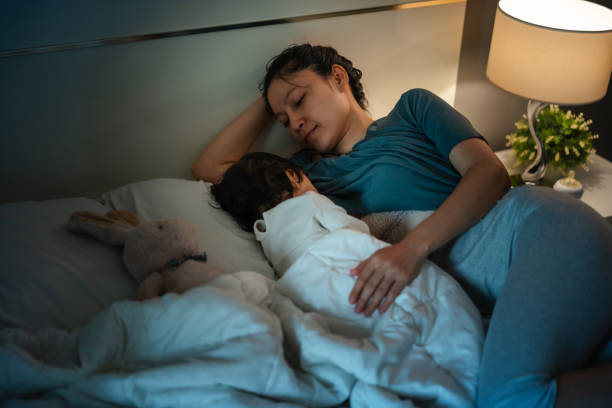You finally rock your baby to sleep, arms tingling, knees creaking, bladder begging, and the moment you try to lower them into the crib, boom. Eyes pop open—mouth quivers. Cry escalates. It’s as if their mattress is made of lava.
Sound familiar?
If you’re whisper-yelling “why won’t you sleep without me?” into the darkness, you’re not alone. So many new parents find themselves in this very moment, night after night, whispering silent deals with the universe in exchange for just one solid hour of rest. But here’s the thing, it’s not you. It’s not your baby being “spoiled,” either. There’s something deeper going on, and we’re going to walk through it all without the guilt and without the cry-it-out stress.
Let’s start with the heart of it.
Your Baby’s Brain Is Wired for Snuggles (Not Solo Sleep)
Babies are born with one mission: survive and stay close to the people who keep them alive. That’s you.
From the first breath they take, babies are biologically wired to seek connection. When they’re in your arms, your warmth regulates their body temperature. Your scent calms their nervous system. The rise and fall of your breathing, your heartbeat, your voice, it all tells them they’re safe.
Now take all that away, plop them in a still, quiet crib, and it feels… off. The primitive part of their brain doesn’t know the crib is a secure, Pinterest-perfect place. All it knows is that the safety cues, your smell, heartbeat, and motion, are gone.
And so, cue the wailing.
Here’s a term that’ll help make sense of it all: contact sleep. It’s how newborns are used to sleeping, against you. The warmth, motion, smell, and sound mimic the womb. When your baby insists on being held to sleep, they’re not being manipulative. They’re doing what evolution taught them.
But that doesn’t mean you have to live with a baby glued to your chest for the next 18 months. Let’s talk about why this habit sticks, and how to gently shift it.
How the “Only-in-Your-Arms” Sleep Cycle Starts (and Stays)
Here’s the slippery slope that so many of us fall into, because it works.
Your baby fusses. You hold them. They calm. They fall asleep. You try to lay them down, nope. So you pick them up again. The cycle continues.
Over time, this creates what’s called a sleep association, basically, your baby learns that falling asleep equals being held. It’s their cue. And because babies are creatures of habit (aren’t we all?), they start to need that cue every time they’re sleepy. Especially during those tricky early phases when they’re cycling through light sleep every 45-60 minutes.
Let me guess, you’re bouncing on a yoga ball at 2 AM, swaying in the dark like a sleep-deprived sea captain. Right?
You’re not failing. You’re adapting. Now we just need to help your baby adapt, too.
Gentle Ways to Help Your Baby Sleep Without Being Held
Okay, deep breath. We’re not going cold turkey here. No harsh sleep training. No timers. No guilt. Just some subtle shifts that build trust and promote sleep independence.
1. Pick-Up-Put-Down Method (a.k.a. The Patience Game)
This is a classic no-cry approach. When your baby fusses after being laid down, you pick them up, soothe them only until calm, and gently lay them back down. Repeat as needed. Yes, it might feel like a workout at first, but over time, they learn that the crib isn’t so scary.
2. Create a Sleepy-Time Environment That Feels Like You
Make the crib feel familiar:
- Use a worn t-shirt (tied safely outside the crib) to mimic your scent
- Try white noise (the Hatch Rest or Yogasleep Dohm are great options)
- Keep lighting low and warm, and avoid blue light
- Swaddle or use a sleep sack for that snuggled-up feeling
3. Be the Chair Next to the Crib (Literally)
For older babies (4 months+), sit beside the crib and offer soothing touch, patting, shushing, and gently rubbing their tummy. It helps your baby learn that they can fall asleep near you, not on you.
This transitional support builds confidence.
Timing Really Is Everything
You know how frustrating it is to try to fall asleep when you’re overtired and wired? Babies are the same. Except instead of binge-watching reruns, they scream.
Catching your baby’s sleepy window is key. Yawning, staring off, rubbing eyes, and slight fussiness are your cues. Wait too long, and their body releases cortisol (stress hormone), which ironically makes it harder to fall asleep.
And speaking of timing.
The Nap Trap
Long naps on your chest during the day feel wonderful, but they can backfire if they throw off night sleep. That said, don’t stress too much. Some days, contact naps are what everyone needs. But aim for at least one crib nap a day to start building independent sleep skills.
Sometimes, It’s Not Just Sleep; Other Things Might Be Going On
Let’s not ignore the fact that sometimes babies won’t sleep unless held because something hurts or feels wrong. Keep an eye out for:
- Reflux: Lying flat aggravates it. You may notice more spitting up, arching, or coughing.
- Gas: Happens more than we think. A gentle tummy massage or bicycle legs can help.
- Teething: Drooling, red cheeks, chewing… and very clingy behaviour.
- Developmental leaps: Babies are learning so fast, it messes with sleep!
If something feels off, trust your gut. Reach out to your paediatrician for peace of mind.
What If You’ve Tried Everything and Nothing’s Working?
Sometimes it’s not about the baby. Sometimes it’s about you.
If you’re hitting a wall, mentally, emotionally, or physically, it’s okay to pause. Talk to someone. Ask your partner to take the next shift. Book a session with a sleep consultant or postpartum therapist. You are not failing.
Sleep deprivation is a form of torture for a reason. It’s okay to say, “I need help.”
Real Stories from the Sleepless Trenches
“I used to dread bedtime,” says Amanda, mom of 3 in Phoenix. “I cried more than my baby did. I felt trapped in this tiny body every night. But when I started just putting a chair next to the crib and humming until she drifted off… it got easier. Like way easier.”
Then there’s James, a single dad from Nairobi: “I literally slept on a yoga mat next to the crib for a week. But by day five, she was sleeping on her own. It was a miracle. Or maybe just persistence.”
Sometimes we just need to hear: this works for real people, not just sleep gurus on Instagram.
You’re Not Just a Parent, You’re a Safe Place
Your baby doesn’t need you to be perfect. Just present. Consistent. A little creative.
The truth is, needing to be held to fall asleep isn’t a problem to fix. It’s a transition to support. And transitions take time.
Even the gentlest of sleep shifts can feel like a marathon. But you’re doing it. Every time you put that baby down (even if they pop back up), you’re planting a seed.
And eventually, sometimes slowly, all at once, they’ll learn to rest on their own.
And you? You’ll get to sleep with both arms free. Imagine that.
Final Thoughts: Sleep Will Come. So Will Peace.
If your baby won’t sleep unless held, you are not doing it wrong. You’re doing it with love. You’re meeting your baby exactly where they are. And that’s more than enough.
Try a few small tweaks. Make the crib feel like your arms. Stay close. Stay patient. Ask for help when it’s too much.
One day soon, you’ll lay your baby down and they’ll stay asleep.
And you’ll whisper: “We made it.”

